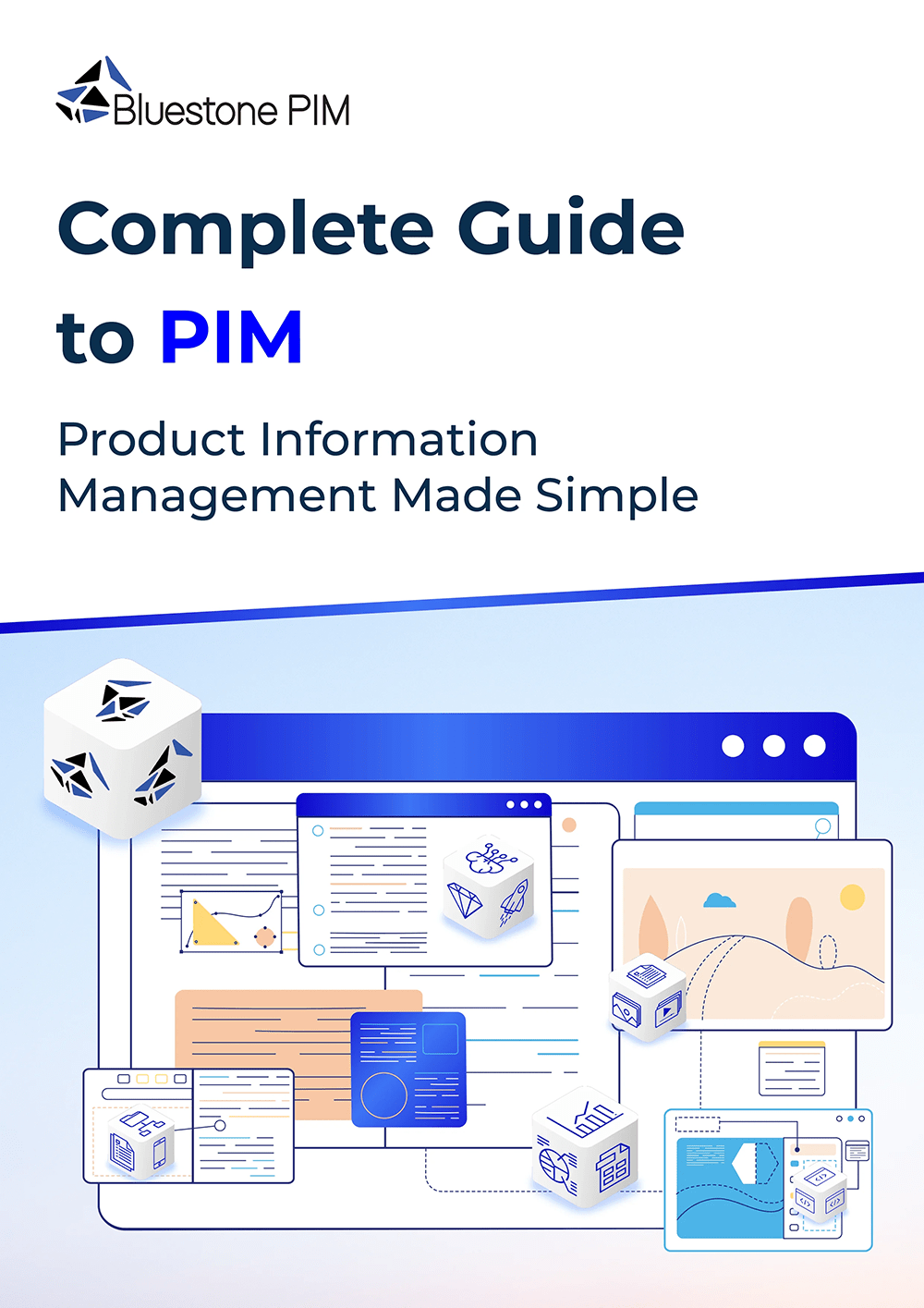6 Key Metrics for Evaluating Product Data Quality Using a PIM System

The amount of data is growing rapidly worldwide.
The Digitization of the World From Edge to Core report by IDC and Seagate states that the total amount of data created and stored in the cloud, enterprise infrastructure, and digital endpoints worldwide—the so-called “Global Datasphere"—is predicted to increase from an estimated 33 zettabytes in 2018 to a staggering 175 zettabytes in 2025.
That is a leap of 5 times the amount of data created, captured, and replicated globally in only seven years.
The IDC report also shows that data growth will be greatest in enterprises’ data centers. While technological advances such as AI and IoT are generating more data than ever before, organizations need to manage this flood of data effectively.
Furthermore, it is equally important to maintain the quality of the data. For retail and eCommerce, ensuring accurate and complete product data across systems is a growing challenge, as poor product data quality can have a negative impact on the customer experience and the bottom line.
In this article, we look at the key metrics for measuring product data quality so you can identify issues that need to be addressed and discuss how product information management (PIM) can help optimize, maintain, and systematically manage product data quality.

DOWNLOAD FREE E-BOOK
The Only PIM Guide You Need
Packed with clear explanations, real examples, and practical advice, this guide shows how to manage product data efficiently, improve consistency across channels, and speed up time-to-market.
What Is Product Data Quality?
Data quality is the degree to which a dataset meets a user's needs.
In this sense, product data quality refers to how well key product information—such as names, descriptions, prices, specifications, and images—has been depicted and how well shoppers can use this information to understand the product offering. For example, incomplete or poor-quality product descriptions or a lack of supporting media can frustrate potential buyers, resulting in lost conversions and abandoned carts.
It also affects a company's ability to efficiently manage marketing and sales campaigns, as well as product listings.
Consequences of Poor Data Quality
Poor product data quality can appear in the form of missing, outdated or incorrect information on product pages and packages.
They may seem trivial to some business owners, but for certain customers they can spoil or hinder the shopping experience and mean the difference between completing the purchase and cancelling the transaction altogether.
In fact, a 2021 global survey revealed that 60.7% of online shopping carts fail to make it to the checkout stage, with poor product data (incomplete descriptions, outdated information, or lack of quality images) being a significant cause.
Moreover, statistics from an Acceldata survey showed that 45% of data executives experienced 11–25 failures in the data pipeline in the last two years due to late-discovered quality errors, and 43% said such failures had affected the customer experience.
Gartner also estimates that data quality issues cost organizations an average of $12.9 million per year.

Poor product data quality can ruin the customer shopping experience
As global companies expand their extensive product offerings, the manual analysis and maintenance of all product data becomes increasingly complex, particularly when dealing with thousands of unique SKUs stored in different spreadsheets and systems.
Relying solely on human labour makes it difficult to ensure data quality over time. As their operations grow, these companies are realizing that they need improved processes and controls to properly manage their growing volumes of product data.
To improve this, companies need to focus on organizing and centralizing their product data in a single system, ensuring consistent data at every touchpoint. Centralized repositories help streamline workflows and reduce the chances of errors. Moreover, automating processes can save time and ensure accuracy when handling large data sets.
Thankfully, there are ways to do it quickly and efficiently (Bluestone PIM!) and hacks to improve product data quality and maintain it.
But first things first, you have to evaluate the quality of your product data and identify which data needs to be completed or corrected.
6 Metrics for Measuring Product Data Quality
To assess the quality of product data, you first need to know what the most important key metrics are.
While some sources list up to twelve dimensions for assessing overall data quality, at Bluestone we have found through our work with retailers and eCommerce companies that the six most important metrics for assessing product data are: Accuracy, Completeness, Consistency, Validity, Uniqueness and Timeliness.
Let’s take a closer look at each of these metrics.
Data Accuracy
Accuracy means that the data matches the actual specifications and details of the product.
An accuracy error such as specifying the wrong color or material for a garment on the product page can result in a customer receiving a product they did not expect. This mismatch between the data and the actual item can lead to a disappointed customer, a negative review and a headache when processing returns and refunds.
Data Completeness
Completeness refers to the inclusion of all relevant product details in the data. This means that specifications, photos, attributes and other supporting media are included in the data set. High-quality product data should include not only descriptions but also rich media like images, videos, and even 360° views to give the customer a fuller understanding of the product.
Incomplete product data means that customers are missing important information that they need to make a purchase decision. This can result in them seeking information from other retailers, abandoning their shopping basket altogether or buying an alternative product from a competitor instead. The result is lost sales and revenue opportunities for your company.
Data Consistency
Consistency ensures that product data is uniform across all channels, such as product catalogues, sales platforms, and internal databases.
In omnichannel retail environments, inconsistent data can disrupt the seamless shopping experience that customers are used to. For example, if a customer follows a social media advert to the product detail page and finds conflicting information, not just will they be confused, but they may also question the credibility of your brand.
Data Validity
In common English usage, "to be valid" means to be acceptable and applicable. In relation to data, it means that the information in a data set is accurate and reliable and can be used for its intended purpose.
However, for data to be considered valid, it must adhere to predefined standards or rules.
Maintaining validity over time requires continuous monitoring to ensure that the data complies with applicable specifications and guidelines. API-based data management is often used for this purpose, as its protocols can systematically check attributes, identify non-compliant values and flag them for correction.
Consistent data validation reduces the risk of customers receiving inaccurate product information and helps companies avoid making poor decisions based on bad data. The validity of product data is particularly important in highly regulated sectors such as pharmaceuticals, where strict rules determine the accuracy of information provided to patients.
Data Timeliness
Timeliness refers to the availability and accessibility of data when it is needed, whether by customers or internal teams.
For example, if a marketing manager needs up-to-date product specifications by next Tuesday to launch an online campaign, they may not be able to develop the campaign at all if they don't have the updated data in time. If outdated information was used, it could derail the entire campaign.
Similarly, if a customer asks a sales representative about the latest item features during a store visit, but the staff doesn't have access to the most current product information, they run the risk of providing inaccurate answers that damage the customer's trust or being unable to assist the customer.
Data Uniqueness
Uniqueness is the state in which each data set is completely unique and different from other entries within the data set.
Sometimes data duplication occurs inadvertently. For example, the same product and associated information may be added twice by different departments who are unaware that it has already been added. Importing large amounts of data can also lead to duplicates creeping into the data set, especially if it is done manually and without a data standardization process.
Cleansing and reducing duplicates is an essential part of data management as it improves the overall data quality index and makes the data easier to organize and work with.
Maintaining high-quality product data in these important areas is a major challenge, especially for retailers with large, complex product catalogues. So how does a brand like IKEA with about 300,000 SKUs keep all that information synchronized, accurate and consistent?
They use a data management system like Master Data Management (MDM) or Enterprise Resource Planning (ERP).
However, for retailers who need help with product data specifically, a Product Information Management (PIM) solution is the most effective option.
How to Improve Product Data Quality in 6 Steps
High-quality product data is the foundation for digital marketing and sales, driving online sales, influencing purchasing decisions, and boosting customer satisfaction. To elevate product data quality, follow these simple yet effective steps.
-
Analyze the current state of product data — identify major challenges, data sources, and areas where data is incomplete or inconsistent.
-
Collect and centralize product data — keeping all your data in one place saves time and makes sure it's accurate, cutting down on duplicates and mistakes.
-
Organize and automate — categorize data systematically and automate workflows to ensure accuracy and timeliness.
-
Enrich product data with media assets — use images, videos, and interactive content to make product information more engaging and appealing. Remember, customers often buy with their eyes!
-
Update data regularly — ensure timely updates to reflect changes in product specifications, availability, or pricing.
-
Seek customer feedback — keep collecting customer feedback to spot where you can make things better.
It might seem like a lot of steps, but here’s the good news: a PIM system simplifies and boosts product data quality management by centralizing, organizing, and automating your data processes. Let’s see how it works.
How PIM Can Help with Product Data Quality Management
Every brand knows that keeping thousands of pieces of product data up to date and synchronized across numerous online and offline touchpoints is an immense undertaking — especially when you're selling globally.
Thankfully, a PIM system provides the necessary infrastructure to systematically manage data quality across huge global catalogues.
This is how it tackles the challenges head-on.
Establish a Single Source of Truth
It is extremely difficult, if not impossible, to keep product information accurate and coordinated across different systems when multiple copies exist separately. Teams have no way of ensuring that they are working with the final master data set and not outdated copies.
A PIM system solves this problem by consolidating data from all sources into a single system. It creates a centralized location where all relevant product information is stored as the authoritative source of truth.
In addition, most PIM solutions also offer integrated digital asset management (DAM) functions. This allows all product images, documents and other marketing assets to be stored, edited, and managed directly in the PIM. For companies with advanced asset management needs, some PIM solutions offer API integration options to connect to an external DAM system of their choice.
By managing all data through this centralized database, the PIM provides the assurance that everyone involved is working with the same accurate information. This not only creates a basis for ensuring data quality but also for the consistency and uniqueness of data in all systems.
Import and Export Reliable Product Information
Now that the PIM has created a single authoritative source of truth, product information can be imported from multiple sources. However, before this information can be considered reliable for downstream use, it must undergo a rigorous validation and cleansing process.
During import, the PIM validates data integrity by checking for duplicates, incorrect entries or values that do not comply with the predefined rules. Bad data is flagged for review to prevent it from spreading further.
In the next step, the system standardizes the data into a uniform format. For example, all date fields are converted to YYYY-MM-DD to ensure consistency. Strict enforcement of standardized field configurations and formats strengthens the validation process.
This process ensures that the highest standards of data validity and accuracy are met and that the product data in the PIM is not only reliable, but can also be reliably used in all business systems and marketing initiatives.
Confirm the State of Data Completeness
Ensuring comprehensive and consistent product information is crucial for success across all sales channels. A PIM system can facilitate the verification of data completeness through scoring metrics such as Bluestone PIM's Completeness Score.
This metric provides an overview of how complete the product data is compared to the incomplete fields for catalogues, categories or individual products. It helps to identify issues that prevent a complete data set, such as missing attributes, incorrectly sized images or text that is not in the correct language, and flag these for review and correction.
This assessment serves to continuously enrich the product information in the PIM. Once the issues are resolved, the PIM can provide complete, optimized product data for consistent, accurate product presentation on online marketplaces and other sales channels.
.jpg?width=750&height=383&name=Completeness-score-01%20(2).jpg)
The Completeness Score tells you what other information your product is missing and how you can maximize its visibility on the marketplaces.
Automatic Product Data Syndication
Keeping product information up-to-date across multiple sales channels is a major challenge in manual data exchange processes. Data must be exported, formatted and then imported into each system individually — a time-consuming process that is prone to costly delays and human error.
Product data syndication is the solution for companies that struggle to maintain the timely flow of accurate product information across all channels. The connection between the PIM and other systems is established via APIs, so that any changes in the PIM are immediately pushed to the designated channels through these automated workflows.
Now customers always receive consistent, accurate product content, regardless of the sales or marketing channel used, and organizations can better support data timeliness while freeing up resources for other tasks.
What Else Can PIM Do?
Product information management significantly accelerates the evaluation and improvement of product data quality, but this is not its only function.
A robust PIM can streamline global sales and marketing initiatives in more ways than one. Not only can the same solution manage multilingual content for greater international reach, but it can also manage variants of product catalogues for different regions and optimise the content of product detail pages for different markets. Generative AI capabilities can create attention-grabbing product descriptions with the desired tone, while automated workflows can prepare printed and digital product catalogues with the assets stored in the PIM system.
For large, global companies, an enterprise-grade PIM system that offers these benefits is a guarantee that it can grow with future needs. If your company is looking for a future-proof PIM solution, instead of a monolithic solution, you should consider a solution based on the MACH architecture that can also enable composable commerce.
To learn more about Bluestone PIM and the MACH architecture it is built on, download our free eBook "The First MACH-Based PIM".

DOWNLOAD FREE E-BOOK
The First MACH-Based PIM
Learn how MACH-based PIM works in practice and what it can do for your business.
Are you striving to maintain high-quality product data for every channel and every system? Bluestone PIM can help you. Get in touch with our consultants to learn how our solution can help you, book a personal demo to see a live presentation, or watch our demo videos to get a quick insight into our PIM capabilities.




